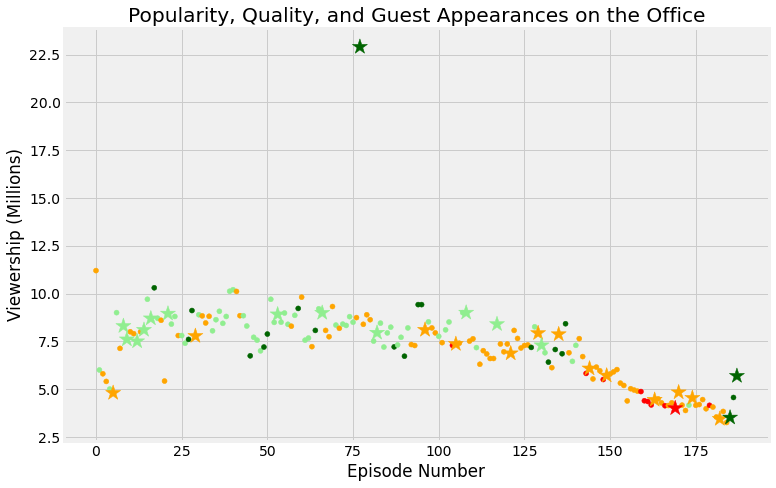Guest Star in the Office
- Omnia Sayed
- Oct 13, 2021
- 4 min read
Introduction
In this blog we try to explain how a simple data investigation task can be done on a dataset,we will try to get some hands on coding skills on how to use Python libraries - specifically Pandas and Matplotlib - to answer questions about data and try to manipulate data to find useful insights and information that we wouldn't notice without those techniques, the used dataset in this article is 'Office Series Investigation Dataset' and the part explained are part of a DataCamp project that you'll fully understand after finishing this article, though this investigation can be generalized and be used in the same manner for even bigger and more complex datasets with slightly small changes.

The Office! What started as a British mockumentary series about office culture in 2001 has since spawned ten other variants across the world, including an Israeli version (2010-13), a Hindi version (2019-), and even a French Canadian variant (2006-2007). Of all these iterations (including the original), the American series has been the longest-running, spanning 201 episodes over nine seasons.
The data set was downloaded from Kaggle here. And also this is one of the DataCamp projects.
We will go through the available data set which contains some characteristics and features for each episode as follows:
episode_number: Canonical episode number.
season: Season in which the episode appeared.
episode_title: Title of the episode.
about: Description of the episode.
ratings: Average IMDB rating.
votes: Number of votes.
viewership: Number of US viewers in millions.
duration: Duration in the number of minutes.
Date: Airdate.
guest_stars: Guest stars in the episode (if any).
director: Director of the episode.
writers: Writers of the episode.
First:
Import libraries Like Pandas and Matplotlip to read a dataset:
import pandas as pd
import matplotlib.pyplot as pltSecond Step:
Read a date from a file
plt.rcParams['figure.figsize'] = [11, 7]
office_df = pd.read_csv('datasets/office_episodes.csv',parse_dates=["release_date"])
office_df.info()Output of first 2 steps
<class 'pandas.core.frame.DataFrame'>
RangeIndex: 188 entries, 0 to 187
Data columns (total 14 columns):
# Column Non-Null Count Dtype
--- ------ -------------- -----
0 episode_number 188 non-null int64
1 season 188 non-null int64
2 episode_title 188 non-null object
3 description 188 non-null object
4 ratings 188 non-null float64
5 votes 188 non-null int64
6 viewership_mil 188 non-null float64
7 duration 188 non-null int64
8 release_date 188 non-null datetime64[ns]
9 guest_stars 29 non-null object
10 director 188 non-null object
11 writers 188 non-null object
12 has_guests 188 non-null bool
13 scaled_ratings 188 non-null float64
dtypes: bool(1), datetime64[ns](1), float64(3), int64(4), object(5)
memory usage: 19.4+ KBThird Step:
Let's visualize the Episode Number vs Viewers in Millions in a plot befre any label and title:
#Create Scatter Plot in Beginning Before Any Thing
fig = plt.figure()
plt.scatter(x=office_df['episode_number'],y=office_df['viewership_mil'])
plt.show()
Fourth step:
A color scheme reflecting the scaled ratings of each episode, so that we put a condition to each rate:
We can a full visualization for the data that can describe it very well, we will plot the same as before except that we will put colors to describe how well each episode is rated, red color less than 0.25, orange color between 0.25 and 0.5, lightgreen color for rates between 0.5 and 0.75, darkgreen color more than 0.75 which are very high rates, let's code this
#Make Column list to Scaled_rating
cols =[]
for ind, row in office_df.iterrows():
if row['scaled_ratings'] < 0.25:
cols.append('red')
elif row['scaled_ratings'] < 0.50:
cols.append('orange')
elif row['scaled_ratings'] < 0.75:
cols.append('lightgreen')
else:
cols.append('darkgreen')
cols[:20]Output to first 20 column before see in scatter plot:
['orange',
'lightgreen',
'orange',
'orange',
'lightgreen',
'orange',
'lightgreen',
'orange',
'lightgreen',
'lightgreen',
'orange',
'orange',
'lightgreen',
'orange',
'lightgreen',
'lightgreen',
'lightgreen',
'darkgreen',
'lightgreen',
'orange']fifth step we make:
Knowing a size of Guest
We want to create one last column, which will be the size of our plots. So in case, we have guest stars its value will be 250 otherwise it will be 25.
#Knowing Size of Guest
size = []
for ind, row in office_df.iterrows():
if row['has_guests'] == False:
size.append(25)
else:
size.append(250)
sizeOutput of Size in small scale to see some of visualize our data:
[25,
25,
25,
25,
25,
250,
25,
25,
250,
250,
]
Define a color to cols and sizes to size:
office_df['colors']=cols
office_df['sizes']=size
office_df.info()Now let's move to some visualization to present our findings and analysis by visualizing the viewership across years:
#Add Col and size to Scatter plot
fig = plt.figure()
plt.scatter(x=office_df['episode_number'],
y=office_df['viewership_mil'],
c=cols,
s=size
)
plt.show()
Know we add a tittle and label to our visualize our Dataset:
#put title,xlabel,ylabel to Scatter plot
fig = plt.figure()
plt.scatter(x=office_df['episode_number'],
y=office_df['viewership_mil'],
c=cols,
s=size
)
plt.title("Popularity, Quality, and Guest Appearances on the Office")
plt.xlabel("Episode Number")
plt.ylabel("Viewership (Millions)")
plt.show()
Let's make two data frames from the original ,that contains guest stars and one that has not:
non_guest_df= office_df[office_df['has_guests']==False]
guest_df= office_df[office_df['has_guests']==True]Know we make a scatter plot after we make a classfication to non_guest and guest and see this in code and scatter plot:
#Make A classfication to non_guest and guest
fig = plt.figure()
plt.style.use('fivethirtyeight')
plt.scatter(x=non_guest_df['episode_number'],
y=non_guest_df['viewership_mil'],
c=non_guest_df['colors'],
s=non_guest_df['sizes']
)
plt.scatter(x=guest_df['episode_number'],
y=guest_df['viewership_mil'],
c=guest_df['colors'],
s=guest_df['sizes'],
marker='*'
)
plt.title("Popularity, Quality, and Guest Appearances on the Office")
plt.xlabel("Episode Number")
plt.ylabel("Viewership (Millions)")
plt.show()
we should make a condition to get maximum guest to get our to star see this in code:
#Put a condition to get top star
office_df[office_df['viewership_mil'] == office_df['viewership_mil'].max()]['guest_stars']#Get Name of top star
top_star = "Cloris Leachman"Finally we visualize our Datset in a detail and move step by step in our project
Acknowledgment
The dataset used for this article is downloaded from kaggle and you can find it here , and the project Unguided Project on DataCamp you can refer to the original project here.
That was part of the Data Insight's Data Scientist Program.









Comments